View in other NatureServe Network Field Guides
NatureServe
Montana
Utah
Wyoming
Idaho
Wisconsin
British Columbia
South Carolina
Yukon
California
New York
Hutchinsia - Hornungia procumbens
Other Names:
Hutchinsia procumbens
State Rank Reason (see State Rank above)
Rare in Montana. Currently known from approximately a half-dozen occurrences scattered across the mountainous portion of the state. Trend and population data are generally lacking, though it is an annual and populations probably fluctuate widely from year to year. Threats to the species' viability in Montana appear to minimal.
- Details on Status Ranking and Review
Population Size
Score1-2 - Small to Moderate. Population size is imprecisely known but is believed to be >2,000 individuals and <100,000 individuals.
CommentPopulation levels are poorly documented and each occurrence has only one observation.
Range Extent
Score1 - Peripheral, Disjunct or Sporadic Distribution in MT: Widespread species that is peripheral, disjunct or sporadically distributed within MT such that it occurs in <5% of the state (<7,500 sq. miles or the combined area of Beaverhead and Ravalli Counties) or is restricted to 4-5 sub-basins.
Area of Occupancy
Score2 - Low: Generally occurring in 4-10 Subwatersheds (6th Code HUC’s).
Environmental Specificity
Score1 - Moderate: Species is restricted to a specific habitat that is more widely distributed or to several restricted habitats and is typically dependent upon relatively unaltered, good-quality habitat (C Values of 5-7).
Trends
ScoreNA - Rank factor not assessed.
Threats
Score0-1 - Low to Medium.
Intrinsic Vulnerability
Score1 - Moderate Vulnerability: Specific biological attributes, unusual life history characteristics or limited reproductive potential makes the species susceptible to extirpation from stochastic events or other adverse impacts to its habitat and slow to recover.
Raw Conservation Status Score
Score
6 to 8 total points scored out of a possible 16 (Rarity factors and threats only).
General Description
Hornungia procumbens is an annual with branched, erect stems that are 2-10 cm high. Alternate, narrowly lance-shaped leaves, 5-20 mm long with entire margins or a pair of basal lobes, are largest at the base of the plant. Foliage is glabrous. Numerous tiny, stalked flowers are borne at the top of the stems in a spreading, elongate inflorescence. Each flower has 4 white, separate petals that are ca. 1 mm long, which fall shortly after opening. The glabrous, egg-shaped fruits, or siliques, are 3-5 mm long and borne on spreading stalks that are up to 10 mm long.
Phenology
Flowering in June, mature fruit in July.
Diagnostic Characteristics
The lack of a basal rosette separates Hornungia from Draba. Lepidium, Thlaspi and Alyssum have fruits that are notched or flattened on top. Small mustards such as Hornungia may be difficult to identify. A technical manual should be consulted, and a hand lens may be required.
Species Range
Montana Range
Range Descriptions
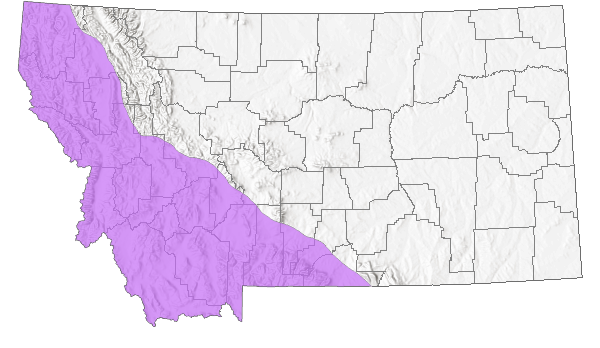
 Native
Native
Range Comments
BC and MT south to CA; Eurasia (Lesica et al. 2012. Manual of Montana Vascular Plants. BRIT Press. Fort Worth, TX).
Observations in Montana Natural Heritage Program Database
Number of Observations: 9
(Click on the following maps and charts to see full sized version)
Map Help and Descriptions
Relative Density
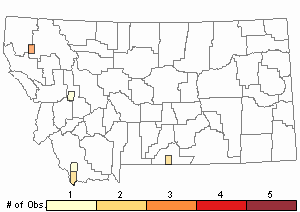
Recency

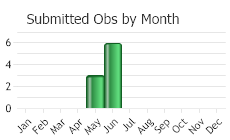
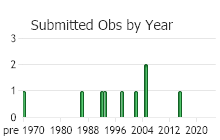
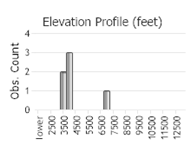 (Observations spanning multiple months or years are excluded from time charts)
(Observations spanning multiple months or years are excluded from time charts)
Habitat
Vernally moist, alkaline soil of sagebrush steppe in the valley to lower montane zones.
National Vegetation Classification System Groups Associated with this Species
Shrubland
Sagebrush Shrubland
Wetland and Riparian
Alkaline - Saline Wetlands
Alpine Riparian and Wetland
Riparian Shrubland
Wet Meadow and Marsh
Stewardship Responsibility
Threats or Limiting Factors
STATE THREAT SCORE REASON
Threat impact not assigned because threats are not known (MTNHP Threat Assessment 2021).
References
- Literature Cited AboveLegend:
 View Online Publication
View Online Publication Lesica, P., M.T. Lavin, and P.F. Stickney. 2012. Manual of Montana Vascular Plants. Fort Worth, TX: BRIT Press. viii + 771 p.
Lesica, P., M.T. Lavin, and P.F. Stickney. 2012. Manual of Montana Vascular Plants. Fort Worth, TX: BRIT Press. viii + 771 p. MTNHP Threat Assessment. 2021. State Threat Score Assignment and Assessment of Reported Threats from 2006 to 2021 for State-listed Vascular Plants. Botany Program, Montana Natural Heritage Program, Helena, Montana.
MTNHP Threat Assessment. 2021. State Threat Score Assignment and Assessment of Reported Threats from 2006 to 2021 for State-listed Vascular Plants. Botany Program, Montana Natural Heritage Program, Helena, Montana.
- Additional ReferencesLegend:
 View Online Publication
View Online Publication
Do you know of a citation we're missing? Lackschewitz, K., P. Lesica, and J. S. Shelly. 1988. Noteworthy collections: Montana. Madrono 35:355-358.
Lackschewitz, K., P. Lesica, and J. S. Shelly. 1988. Noteworthy collections: Montana. Madrono 35:355-358. Lesica, P. 1994. The distribution of plant community diversity associated with glacial wetlands in the Ovando Valley, Montana. [Unpublished report.] The Nature Conservancy, Montana Field Office, Helena. 26 pp.
Lesica, P. 1994. The distribution of plant community diversity associated with glacial wetlands in the Ovando Valley, Montana. [Unpublished report.] The Nature Conservancy, Montana Field Office, Helena. 26 pp. Lesica, P., M.T. Lavin, and P.F. Stickney. 2022. Manual of Montana Vascular Plants, Second Edition. Fort Worth, TX: BRIT Press. viii + 779 p.
Lesica, P., M.T. Lavin, and P.F. Stickney. 2022. Manual of Montana Vascular Plants, Second Edition. Fort Worth, TX: BRIT Press. viii + 779 p. Vanderhorst, J.P. and P. Lesica. 1995a. Sensitive plant survey of the Tendoy Mountains in the Beaverhead National Forest, Beaverhead County, Montana. Unpublished report to the Bureau of Land Management, Butte District. Montana Natural Heritage Program, Helena, MT. 59 pp. plus appendices.
Vanderhorst, J.P. and P. Lesica. 1995a. Sensitive plant survey of the Tendoy Mountains in the Beaverhead National Forest, Beaverhead County, Montana. Unpublished report to the Bureau of Land Management, Butte District. Montana Natural Heritage Program, Helena, MT. 59 pp. plus appendices.
- Web Search Engines for Articles on "Hutchinsia"





